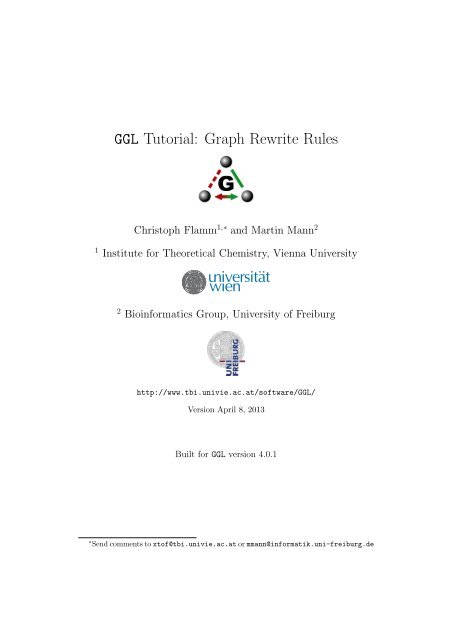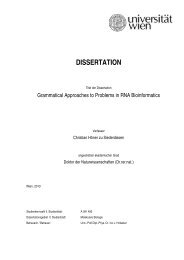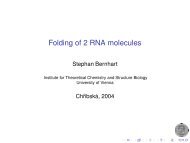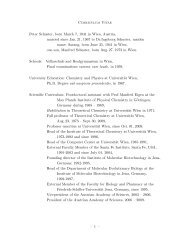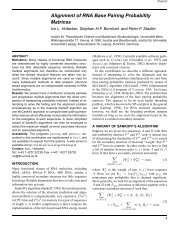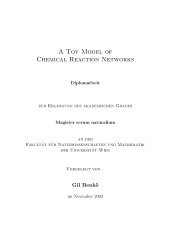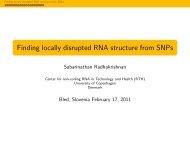GGL Tutorial: Graph Rewrite Rules - TBI
GGL Tutorial: Graph Rewrite Rules - TBI
GGL Tutorial: Graph Rewrite Rules - TBI
Create successful ePaper yourself
Turn your PDF publications into a flip-book with our unique Google optimized e-Paper software.
<strong>GGL</strong> <strong>Tutorial</strong>: <strong>Graph</strong> <strong>Rewrite</strong> <strong>Rules</strong><br />
Christoph Flamm 1,∗ and Martin Mann 2<br />
1 Institute for Theoretical Chemistry, Vienna University<br />
2 Bioinformatics Group, University of Freiburg<br />
http://www.tbi.univie.ac.at/software/<strong>GGL</strong>/<br />
Version April 8, 2013<br />
Built for <strong>GGL</strong> version 4.0.1<br />
∗ Send comments to xtof@tbi.univie.ac.at or mmann@informatik.uni-freiburg.de
Contents<br />
1 <strong>Graph</strong> rewrite rules 1<br />
1.1 Introduction to the specification language GML . . . . . . . . . 1<br />
1.2 BNF of GML . . . . . . . . . . . . . . . . . . . . . . . . . . . . 1<br />
1.3 Keys for rule specification . . . . . . . . . . . . . . . . . . . . 2<br />
2 Chemical graph rewrite rules 4<br />
2.1 General structure of a rewrite rule . . . . . . . . . . . . . . . . 5<br />
2.2 General steps in the derivation of writing rules . . . . . . . . . 6<br />
2.3 Wildcards for atom/bond label . . . . . . . . . . . . . . . . . 7<br />
2.4 Constraining atoms/bonds . . . . . . . . . . . . . . . . . . . . 7<br />
2.4.1 Constrain allowed atom labels . . . . . . . . . . . . . . 7<br />
2.4.2 Constrain allowed bond labels . . . . . . . . . . . . . . 8<br />
2.4.3 Forbid a certain bond . . . . . . . . . . . . . . . . . . . 9<br />
2.4.4 Constrain adjacency (or degree) . . . . . . . . . . . . . 9<br />
2.5 Radicals . . . . . . . . . . . . . . . . . . . . . . . . . . . . . . 12<br />
2.6 Group placeholders within rules . . . . . . . . . . . . . . . . . 13<br />
2.7 Visualization of chemical rules . . . . . . . . . . . . . . . . . . 15<br />
3 Copy-and-Paste operations 15<br />
4 Examples 16<br />
4.1 Bromination of a double bond . . . . . . . . . . . . . . . . . . 16<br />
4.2 Diels-Alder reaction . . . . . . . . . . . . . . . . . . . . . . . . 16<br />
4.3 Keto-enol isomerization . . . . . . . . . . . . . . . . . . . . . . 17<br />
4.4 Aldose-Ketose transformation . . . . . . . . . . . . . . . . . . 19<br />
2
1 <strong>Graph</strong> rewrite rules<br />
This chapter explains how to describe a graph rewrite rule in term of the<br />
<strong>Graph</strong> Modeling Language (GML). Please note, currently only undirected<br />
graphs are supported and assumed for both the input graphs and the rewrite<br />
patterns. Theoretically, the graph grammar library is prepared to be applied<br />
on directed graphs too, but so far this was not tested nor applied!<br />
1.1 Introduction to the specification language GML<br />
Within the <strong>GGL</strong>, graphs and graph rewrite rules are specified in a language<br />
called GML (<strong>Graph</strong> Modeling Language). Essentially, GML is composed of<br />
hierarchical key–value pairs. Keys are usually strings (some identifiers) and<br />
values specify the value of the corresponding key. Values are either single<br />
values (numbers, strings, etc) or lists of key–value pairs. Lists must always<br />
be enclosed in opening ’[’ and closing ’]’ brackets in GML. Nesting of lists to<br />
arbitrary depth is allowed in GML. The general structure of a GML specification<br />
looks as follows:<br />
key1 [<br />
key2 value2<br />
key3 [<br />
key4 value4<br />
key5 value5<br />
]<br />
key6 value6<br />
]<br />
In the above code snippet keys 1 and 3 have both a list as value (hence the<br />
brackets). Keys 2, 4–6 are key–value pairs where the corresponding values<br />
are single values such as numbers or strings.<br />
1.2 BNF of GML<br />
Following is the grammar specification of GML in Boyes Normal Form (BNF).<br />
1
gml ::= keyvalues<br />
keyvalues ::= keyvalue (keyvalue)*<br />
keyvalue ::= key value<br />
key ::= [’a’-’z’’A’-’Z’][’a’-’z’’A’-’Z’’0’-’9’]<br />
value ::= real | integer | string | list | operator<br />
real ::= sign? digit ’.’ digit+ mantissa?<br />
integer ::= sign? digit+<br />
operator ::= ’’ | ’!’<br />
string ::= ’"’ instring ’"’<br />
list ::= ’[’ keyvalues ’]’<br />
sign ::= ’+’ | ’-’<br />
digit ::= [’0’-’9’]<br />
mantissa ::= (’E’ | ’e’) sign? digit+<br />
instring ::= ASCII-{’&’, ’"’} | ’&’ [’a’-’z’’A’-’Z’] ’;’<br />
The GML-parser in <strong>GGL</strong> can parse any well formed GML file that conforms to<br />
the above BNF grammar specification. However the parser interprets only<br />
a subset of “known” key–value pairs (see according section) all other wellformed<br />
key–value pairs are silently ignored (Note: a source of errors is<br />
misspelling of known keys since the parsing is case-sensitive).<br />
1.3 Keys for rule specification<br />
The following table lists the relevant keys for rule specification in alphabetic<br />
order. Keys underlayed with the color gray are used to set constraints or<br />
copy-and-paste operations on vertices or edges (see section 2.4 and 3 for<br />
more details). For lists the optional enclosed keys are given in brackets.<br />
key type keys in list comment<br />
constrainAdj list id, op, count, (edgeLabels<br />
and/or nodeLabels)<br />
constrainEdge list source, target, (op), edge-<br />
Labels<br />
define adjacency constraints<br />
for a matched vertex, either<br />
nodeLabels or edgeLabels or<br />
both has to be specified<br />
define constraints for the allowed/forbidden<br />
labels for a<br />
matched edge<br />
constrainNoEdge list source, target define constraints that two<br />
matched vertices are not connected<br />
via an edge<br />
2
key type keys in list comment<br />
constrainNode list id, (op), nodeLabels define constraints for the allowed/forbidden<br />
labels for a<br />
matched vertex<br />
context list (node), (edge) define the context-subgraph of<br />
a rule<br />
count int – numeric counter for constrained<br />
rule vertex<br />
copyAndPaste list source, id, (edgeLabels),<br />
(target)<br />
define a copy-and-paste operation<br />
for a left-side only node.<br />
Out-edges of the source node<br />
with the given labels (or all<br />
if no specified) are copied to<br />
the target vertex. Optionally,<br />
the target node of the copied<br />
edges can be specified.<br />
edge list source, target, label define an edge.<br />
edgeLabels list label define a list of edge labels incident<br />
to a constrained vertex,<br />
id int – defines a numerical identifier<br />
for a vertex.<br />
label string – defines a textual label for a<br />
vertex or an edge.<br />
left list (node), (edge), (constraintXXX)<br />
define the left-subgraph of a<br />
rule. In addition several instances<br />
of constrainXXX can<br />
be added to make the rule<br />
matching more specific.<br />
node list id, label define a vertex<br />
3
key type keys in list comment<br />
nodeLabels list label define a list of vertex labels<br />
adjacent to a constrained vertex.<br />
op char – operator used in the logical<br />
expression for constraints<br />
(one of {’’, ’!’}).<br />
right list (node), (edge) define the right-subgraph of a<br />
rule.<br />
rule list ruleID, left, context, right,<br />
(wildcard), (copyAnd-<br />
Paste)<br />
define a rule.<br />
ruleID string – define a textual name for a<br />
rule<br />
source int – define the source-vertex of an<br />
edge<br />
target int – define the target-vertex of an<br />
edge<br />
wildcard string – an optional textual label that<br />
defines which used labels for<br />
a vertex or an edge is to be<br />
matched on any other label<br />
during the left side pattern<br />
matching.<br />
2 Chemical graph rewrite rules<br />
In the following, the general structure of a graph rewrite rule is exemplified<br />
using the special case of instances defining chemical reactions. These can<br />
be applied to model chemical reactions based on a graph representation of<br />
molecules. Therein, molecules are defined by an undirected graph where<br />
each node represents a single atom and edges correspond to bonds of a given<br />
4
valence. Within the <strong>GGL</strong>, we assume node and edge labels to be conform with<br />
the SMILES notation.<br />
Since we are modelling chemical reactions, no atoms (i.e. nodes) are<br />
allowed to vanish or appear during the reaction. Thus, no node will be<br />
exclusively left (for vanishing nodes) or right side (appearing nodes). Label<br />
changes are possible, i.e. a node appears with different label in the left and<br />
right side of the rule. A possible reason for a label change is an altered charge<br />
of an atom as a result of the reaction.<br />
2.1 General structure of a rewrite rule<br />
A rewrite rule is specified with the key rule. Within the list value of the rule<br />
key 4 mandatory keys must be specified, one string valued key (ruleID) to<br />
name the rule and three list valued keys (left, context, right) defining the<br />
three subgraphs of a rewrite rule:<br />
ruleID each rule must have a textual name which must be defined by this key.<br />
left within the list value of this key, all edges are specified, which are broken<br />
during the chemical transformation (i.e. bonds present in the educt but<br />
absent in the product molecule(s)). Furthermore, nodes can be listed<br />
that change their label along the reaction, thus they are listed with<br />
different label within the right list. Finally, the matching can be further<br />
refined listing additional constraints.<br />
context within the list value of this key, all nodes and edges are defined, which<br />
do not change during the chemical transformation.<br />
right within the list value of this key, all edges are specified, which are formed<br />
during the chemical transformation (i.e. which are “new” in the product<br />
molecule(s)). Furthermore, nodes with changing label (i.e. also listed<br />
in left list) are given.<br />
The following example illustrates how a valid rewrite rule looks like. The<br />
atoms 1-4 go into the context since chemistry is mass conserving and no<br />
atom can vanish or can be produced out of the blue during a chemical transformation.<br />
Note also that the total valence (total degree of each node) is<br />
preserved during the chemical reaction. Total valence preservation is a crucial<br />
feature of chemical transformations. The GML-parser in <strong>GGL</strong> checks each<br />
rule to have this property and issues an error message if this is not the case!<br />
5
ule [<br />
ruleID "Double bond bromination"<br />
left [<br />
edge [ source 1 target 2 label "=" ]<br />
edge [ source 3 target 4 label "-" ]<br />
]<br />
context [<br />
node [ id 1 label "C" ]<br />
node [ id 2 label "C" ]<br />
node [ id 3 label "Br" ]<br />
node [ id 4 label "Br" ]<br />
]<br />
right [<br />
edge [ source 1 target 2 label "-" ]<br />
edge [ source 1 target 3 label "-" ]<br />
edge [ source 2 target 4 label "-" ]<br />
]<br />
]<br />
Try to make a sketch of the above reaction and compare your result with<br />
section 4.1. (Hint: arrange the nodes from context into a polygon and<br />
draw only the vertices of the polygon on the left and right side of a reaction<br />
arrow. Insert each edge from context (if any) into both graphs left and<br />
right of the reaction arrow. Finally insert edges from left into the graph<br />
left and those from right into the graph right of the reaction arrow).<br />
2.2 General steps in the derivation of writing rules<br />
It is recommended to follow the protocol below when translating reaction<br />
mechanisms into writing rules.<br />
1. Make a sketch of the reaction.<br />
2. Number the atoms in the reaction mechanism.<br />
3. Figure out which atoms/bonds are constant during the chemical transformation.<br />
(These bonds/atoms go into the context of the rule.<br />
4. Figure out which bonds are broken during the chemical transformation.<br />
(These go into left of the rule).<br />
5. Figure out which bonds are formed during the chemical transformation.<br />
(These go into the right of the rule).<br />
6. Check the action of the rule on examples and counter examples to make<br />
sure that the rule does what you want.<br />
6
2.3 Wildcards for atom/bond label<br />
Generally, a graph rewrite rule has to be explicit, i.e. all node and edge<br />
labels defining the pattern to match have to be given. Sometimes, however,<br />
the specification of a dummy atom of unspecified type is more convenient to<br />
define a chemical rewrite rule to avoid and join a large number of explicit<br />
rules.<br />
To this end, the <strong>GGL</strong> rule specification allows to define what label can<br />
be matched on any other label (applied for both nodes and edges). To this<br />
end, add the wildcard key-value to your rule specification. For instance, the<br />
following rule<br />
rule [<br />
ruleID "wildcard rule"<br />
wildcard "myWildcard"<br />
left [ node [ id 1 label "myWildcard" ] ]<br />
right [ node [ id 1 label "X" ] ]<br />
]<br />
would match on any node and change its label to “X”. Note, the label<br />
for the wildcard can be any string as long as it is specified with the wildcard<br />
key.<br />
Within the chemical reaction encoding, per default the wildcard label ”*”<br />
is defined. It can be used for both atom and bond label specification and<br />
matches any other label. Note, this wildcard label is fixed and hardcoded<br />
and cannot be changed within the chemical framework.<br />
The use of wildcards within rules broadens their applicability but might<br />
result in too general patterns. To this end, additional constraints might<br />
be needed that restrict the generality of the wildcard usage. The currently<br />
supported constraints are discussed in the following.<br />
Note, wildcards are also allowed within some constraints and copy-andpaste<br />
operations as discussed in the following.<br />
2.4 Constraining atoms/bonds<br />
To simplify rule formulation or to make rules more specific, it is sometimes<br />
necessary to further constrain atoms or bonds (of the to-be-matched rule’s<br />
left side). In the following, the available constraints are exemplified.<br />
2.4.1 Constrain allowed atom labels<br />
If an atom label is not explicitly specified using the wildcard character ”*” but<br />
only a specific set of atom labels should be allowed, a node label constraint<br />
has to be set. This can be done use the constrainNode statement.<br />
7
For instance, the following constraint restricts the allowed labels for the<br />
atom with node id 1 to carbon (C) or nitrogen (N). Otherwise, the node<br />
could have been matched with any atom within a molecule.<br />
...<br />
context [<br />
...<br />
node [ id 1 label "*" ]<br />
...<br />
]<br />
left [<br />
constrainNode [ id 1 op = nodeLabels [ label "C" label "N" ] ]<br />
]<br />
...<br />
We can achieve the inverse result when changing the operator to op !<br />
which makes the given node labels the set of forbidden labels. Thus, the<br />
contraint would enforce that the matched node shows none of the given<br />
labels.<br />
2.4.2 Constrain allowed bond labels<br />
As for atom labels, the wildcard character ”*” can be used as an edge label to<br />
enable a general matching definition. One can define constraints in a similar<br />
way to restrict the allowed bond labels using the constrainEdge statement.<br />
For instance, the following constraint restricts the allowed labels for the<br />
bond between the atoms with id 1 and 2 to be a single bond (“–”) or a double<br />
bond (“=”).<br />
...<br />
context [<br />
...<br />
edge [ source 1 target 2 label "*" ]<br />
...<br />
]<br />
left [<br />
constrainEdge [ source 1 target 2 op =<br />
edgeLabels [ label "-" label "=" ]<br />
]<br />
]<br />
...<br />
As for the node label constraint, we can achieve the inverse result when<br />
changing the operator to op ! which makes the given edge labels the set of<br />
8
forbidden labels. Thus, the contraint would enforce that the matched edge<br />
shows none of the given labels.<br />
Note, this constraint is only usefull if either no multiple parallel edges are<br />
possible/present between the constrained source and target nodes or if all<br />
parallel edges between these two nodes are to be constrained.<br />
2.4.3 Forbid a certain bond<br />
Since subgraph isomorphism focuses on the matching of present nodes and<br />
edges, some graph rewrite rules need to explicitely state a non-existance of<br />
a certain edge. This can be done using the constrainNoEdge statement as<br />
exemplified in the following for the nodes with id 1 and 2.<br />
...<br />
constrainNoEdge [ source 1 target 2 ]<br />
...<br />
2.4.4 Constrain adjacency (or degree)<br />
Often it is of interest to constrain the adjacent nodes and edges for a given<br />
node. Using constrainAdj a sophisticated adjacency restriction can be set.<br />
It is based either on a given list of node or edge labels or a combination.<br />
For each constraint the number of nodes/edges matching the given labels<br />
is determined and evaluated according to the given operator and targeted<br />
value.<br />
For instance the following constrain enforces that atom with node id 1<br />
has at least 3 adjacent single bonds (edges with label “–”).<br />
...<br />
constrainAdj [ id 1 op > count 2 edgeLabels [ label "-" ] ]<br />
...<br />
In order to specify that any edge or node label can be matched either a<br />
wildcard label can be specified or the according list can be ommitted. Thus, if<br />
no node or edge labels are given, all nodes/edges are taken into consideration.<br />
If both node and edge labels are specified, only edges are counted where the<br />
edge label and the targeted node label are among the allowed labels.<br />
Therefore, a degree constraint can be simply expressed using<br />
constrainAdj [ id 1 op = count 2 ]<br />
Note: all according nodes and edges are taken into account, i.e. also the<br />
nodes/edges that are explicitely stated within the rule.<br />
A good example to illustrate adjacency constraints is the Cannizzaro<br />
reaction. The reaction involves the base-induced disproportionation (i.e. the<br />
9
self oxydation-reduction reaction) of an aldehyde lacking a hydrogen atom in<br />
the α-position of the carbonyl-group yielding a 50:50 product mixture of the<br />
corresponding alcohole (reduction product) and carboxylic acid (oxydation<br />
product).<br />
O<br />
OH<br />
2<br />
NaOH<br />
H 2<br />
O<br />
+<br />
benzoic aldehyde<br />
benzyl alcohol<br />
benzoic acid<br />
Let us assume that the canizzarro reaction proceeds via a cyclic six-membered<br />
“imaginary transition state” (ITS) (arranging 2 aldehydes and 1 water molecule)<br />
8<br />
H<br />
H<br />
O<br />
3<br />
2<br />
O<br />
4<br />
1<br />
C<br />
6<br />
5<br />
C<br />
H<br />
O<br />
R<br />
9<br />
R<br />
H<br />
7<br />
than the following bond changes happen<br />
• broken bonds: 1–2 (C−O), 3–4 (H−O) and 5–6 (C−H).<br />
• formed bonds: 1–2 (C−O), 2–3 (H−O), 4–5 (O−C) and 6–1 (H−C).<br />
• constant: atoms 1–9 and bonds 1–7 (C−H), 4–8 (O−H) and 5–9 (C−O).<br />
resulting in the rewriting rule<br />
10
ule [<br />
ruleID "cannizzaro reaction too general"<br />
context [<br />
node [ id 1 label "C" ]<br />
node [ id 2 label "O" ]<br />
node [ id 3 label "H" ]<br />
node [ id 4 label "O" ]<br />
node [ id 5 label "C" ]<br />
node [ id 6 label "H" ]<br />
node [ id 7 label "H" ]<br />
node [ id 8 label "H" ]<br />
node [ id 9 label "O" ]<br />
edge [ source 1 target 7 label "-" ]<br />
edge [ source 4 target 8 label "-" ]<br />
edge [ source 5 target 9 label "=" ]<br />
]<br />
left [<br />
edge [ source 1 target 2 label "=" ]<br />
edge [ source 3 target 4 label "-" ]<br />
edge [ source 5 target 6 label "-" ]<br />
]<br />
right [<br />
edge [ source 1 target 2 label "-" ]<br />
edge [ source 2 target 3 label "-" ]<br />
edge [ source 4 target 5 label "-" ]<br />
edge [ source 6 target 1 label "-" ]<br />
]<br />
]<br />
The above rule is very general and matches any aldehyde regardless what R<br />
actually is. However, aldehydes possessing a hydrogen at the atom adjacent<br />
to the carbonyl group (e.g. R = CH 3 ) form the enol tautomer under basic<br />
conditions and cannizzaro reaction is not observed. To make the cannizzaro<br />
rule specific for aldehydes without a hydrogen in the α position of the carbonyl<br />
group, we first have to add two C atoms (10, 11) and the respective<br />
bonds (1–10, 5–11) to the context subgraph and disallow hydrogens on atoms<br />
10 and 11 by using a constrainAdj statement.<br />
11
ule [<br />
ruleID "cannizzaro restrictive"<br />
context [<br />
node [ id 1 label "C" ]<br />
node [ id 2 label "O" ]<br />
node [ id 3 label "H" ]<br />
node [ id 4 label "O" ]<br />
node [ id 5 label "C" ]<br />
node [ id 6 label "H" ]<br />
node [ id 7 label "H" ]<br />
node [ id 8 label "H" ]<br />
node [ id 9 label "O" ]<br />
node [ id 10 label "C" ]<br />
node [ id 11 label "C" ]<br />
edge [ source 1 target 7 label "-" ]<br />
edge [ source 4 target 8 label "-" ]<br />
edge [ source 5 target 9 label "=" ]<br />
edge [ source 1 target 10 label "-"]<br />
edge [ source 5 target 11 label "-"]<br />
]<br />
left [<br />
edge [ source 1 target 2 label "=" ]<br />
edge [ source 3 target 4 label "-" ]<br />
edge [ source 5 target 6 label "-" ]<br />
constrainAdj [ id 10 op = count 0 nodeLabels [ label "H" ] ]<br />
constrainAdj [ id 11 op = count 0 nodeLabels [ label "H" ] ]<br />
]<br />
right [<br />
edge [ source 1 target 2 label "-" ]<br />
edge [ source 2 target 3 label "-" ]<br />
edge [ source 4 target 5 label "-" ]<br />
edge [ source 6 target 1 label "-" ]<br />
]<br />
]<br />
2.5 Radicals<br />
A radical is an atom that has unpaired valence electrons or an open electron<br />
shell, and therefore may be seen as having one or more ”dangling” covalent<br />
bonds. The <strong>GGL</strong> chemistry framework “sanity checks” for rules and<br />
produced molecules do not allow such atoms. Nevertheless, one can still represent<br />
radicals using a simple trick following the observation that radicals are<br />
usually only intermediates of reactions and thus both created and destroyed<br />
12
y a chemical reaction part of the reaction set applied. Therefore, radicals<br />
are represented by atoms with according additional charge information plus<br />
a radical specific class name. The latter ensures the distinction of radicals<br />
encoded in such a way from normal atoms with the same charge. These specific<br />
radical labels are than used in the “destruction” reaction to replace the<br />
radical with the according atom label.<br />
A simple example is the reaction Cl 2 → Cl • + Cl• where chlorine gas<br />
is broken down by ultraviolet light to atomic chlorine radicals. This can be<br />
expressed using<br />
rule [<br />
ruleID "chlorine gas to radical"<br />
context [ ]<br />
left [<br />
node [ id 1 label "Cl" ]<br />
node [ id 2 label "Cl" ]<br />
edge [ source 1 target 2 label "-" ]<br />
]<br />
right [<br />
node [ id 1 label "Cl-:1" ]<br />
node [ id 2 label "Cl-:1" ]<br />
]<br />
]<br />
where Cl-:1 represents the chlorine radicals.<br />
Note: You have to ensure, that the class identifier used to encode for<br />
radicals (here 1) is not used for other class descriptions.<br />
2.6 Group placeholders within rules<br />
The specification of (bio)chemical reactions often requires the representation<br />
of large (unchanged) parts of molecules in order to make the rule as specific<br />
as the chemical reaction. A classic example is the involvement of helper<br />
molecules like ATP, NADH, etc. that are only slightly changed but have to<br />
be represented completely to avoid the application of the rule using similar<br />
molecules.<br />
To this end, the <strong>GGL</strong> supports the specification of molecular groups as<br />
pseudo-atoms within chemical rule definitions. They allow for a much easier<br />
and compact rule definition and avoid potential typos and mistakes.<br />
As an example consider the lactat-dehyrogenase from the citrat-cycle<br />
given by NAD + + lactate → NADH + pyruvate. NADH is a large molecule<br />
comprising 66 atoms. Thus, a complete specification would require the definition<br />
of all NADH atoms and bonds together with the according parts<br />
13
of lactate and pyruvate incorporating 76 atoms in total. Furthermore, this<br />
would be the case for all other NADH-dependent reactions as well.<br />
H10<br />
- :<br />
c2<br />
H7<br />
-<br />
c1<br />
:<br />
:<br />
c3<br />
- : : -<br />
{Ribo-ADP}13<br />
: -<br />
n+0<br />
O-22<br />
H11 c4 H12 C20<br />
-<br />
=<br />
{CONH2}8<br />
c5<br />
O21<br />
-<br />
O24<br />
-<br />
-<br />
- C23 -<br />
-<br />
H27<br />
H26<br />
C25<br />
-<br />
H30 H29<br />
-<br />
-<br />
H28<br />
H10<br />
H27<br />
-<br />
-<br />
-<br />
H11<br />
H+30<br />
=<br />
H7<br />
-<br />
C1<br />
{Ribo-ADP}13<br />
- -<br />
C2 N0<br />
O21<br />
H28 H29<br />
-<br />
-<br />
- - =<br />
C3<br />
- =<br />
-<br />
-<br />
=<br />
-<br />
C25<br />
C4 H12 H26 C23 O-22<br />
{CONH2}8<br />
C5<br />
-<br />
O24<br />
-<br />
C20<br />
-<br />
Figure 1: Lactat-dehydrogenase : NAD + + lactate → NADH + pyruvate.<br />
The picture exemplifies the use of group identifiers to compact the rule specification.<br />
The colors indicate if specified as context (black), left (red), or right<br />
(green). Note, such a representation reduces the rule specification from 76<br />
to only 23 atoms.<br />
Using group identifiers, the definition of the lactat-dehydrogenase becomes<br />
much more compact as exemplified in Fig. 1. With only 23 atoms,<br />
the whole reaction is described. Note, the rule specification uses two group<br />
descriptors. Each is replaced during the rule GML parsing with according<br />
molecule components/subgraphs, i.e. {CONH2} is replaced with a CONH 2<br />
group and {Ribo-ADP} with a ribose and attached adenosine.<br />
Each group shows as interface exactly one proxy node that will replace<br />
the pseudo atom labeled with the group ID. Thus, a rule can only change<br />
bonds with the proxy node, the rest of the group is statically added to the<br />
rule context. It is possible to specify label changes of the proxy node atom<br />
but these are restricted to charge changes as exemplified below. An explicit<br />
change of the proxy node label (e.g. make it aromatic “C” → “c”) is not<br />
possible. Further information on how molecular groups have to be defined<br />
etc. are given in the according tutorial “<strong>GGL</strong> <strong>Tutorial</strong>: Molecular Groups”.<br />
...<br />
left [<br />
node [ id 1 label "{GROUP}" ]<br />
...<br />
]<br />
right [<br />
node [ id 1 label "{GROUP}+" ]<br />
...<br />
]<br />
...<br />
14
2.7 Visualization of chemical rules<br />
The GML definition of chemical rules can become quite large and hard to read.<br />
To ease their creation and to allow for a simple evaluation, the <strong>GGL</strong> sports<br />
the visualization script chemrule2svg.pl within its Perl module.<br />
Given a chemical reaction in GML notation, the script produces a graphical<br />
depiction in Scalable Vector <strong>Graph</strong>ics (SVG) format. Therein, a color coding<br />
is used to highlight what parts are defined in the context (black), left (red),<br />
or right (green) part of the rule. An example is given in Fig. 1.<br />
The chemrule2svg.pl script uses the OpenBabel package to create the<br />
2D depictions of the molecules and thus requires its presence.<br />
3 Copy-and-Paste operations<br />
Some graph operations require the deletion of one or several nodes but need<br />
to maintain and copy the former connectivity of the nodes to be removed.<br />
In such cases, a copy-and-paste operation can be used, specified by the list<br />
keyword copyAndPaste. Within the GML specification the source node to<br />
be deleted (has to be a left-side only node) and a target node to inherit the<br />
connectivity of the source (has to be a non-left node) are specified. Optionally,<br />
a set of edge labels to constrain the edges to copy can be specified. If<br />
no edge label list is given or the wildcard is among the labels, all edges will<br />
be copied. The edges to copy can be further specified by giving the target<br />
node of the edges of interest.<br />
A small example is given in the following:<br />
rule [<br />
ruleID "copy-and-paste"<br />
left [ node [ id 1 label "A" ] ]<br />
context [ node [ id 2 label "B" ] ]<br />
right [ node [ id 3 label "C" ] ]<br />
copyAndPaste [ source 1 id 2 ]<br />
copyAndPaste [ source 1 id 3 edgeLabels [ label "-" ] ]<br />
copyAndPaste [ source 1 id 3 edgeLabels [ label "-" ] target 2 ]<br />
]<br />
Within the example, node A is deleted. But beforehand, all out-edges<br />
of A are copied to node B. In addition, all out-edges of A with the edge label<br />
“–” are copied to the newly created node C. Note, using copy-and-paste<br />
operations it is possible to duplicate edges if needed. This is exemplified<br />
with the third copy-and-paste operation where all edges between node A<br />
and B with edge label “–” are again copied to be edges between node C<br />
15
and B, thus if existing two such edges are created in combination with the<br />
second copy-and-paste operation.<br />
Note, copy-and-paste operations are based on the left side pattern matching,<br />
i.e. the edges copied are without the edges to add from the right-side<br />
and including the edges from the left-side of the rule specification.<br />
4 Examples<br />
4.1 Bromination of a double bond<br />
In this reaction a Br 2 molecule is added to a C−C bond. The reaction is<br />
thought to go via a 4-cyclic transition state (bracketed structure).<br />
3 4<br />
3 4<br />
Br Br<br />
Br Br<br />
1<br />
2<br />
3<br />
Br<br />
1 2<br />
1<br />
2<br />
4<br />
Br<br />
rule [<br />
ruleID "Double bond bromination"<br />
left [<br />
edge [ source 1 target 2 label "=" ]<br />
edge [ source 3 target 4 label "-" ]<br />
]<br />
context [<br />
node [ id 1 label "C" ]<br />
node [ id 2 label "C" ]<br />
node [ id 3 label "Br" ]<br />
node [ id 4 label "Br" ]<br />
]<br />
right [<br />
edge [ source 1 target 2 label "-" ]<br />
edge [ source 1 target 3 label "-" ]<br />
edge [ source 2 target 4 label "-" ]<br />
]<br />
]<br />
4.2 Diels-Alder reaction<br />
The Diels-Alder reaction is a [4+2]-cycloaddition between a conjugated diene<br />
and an alkene, commonly termed the dienophile, to form a (substituted)<br />
16
cyclohexene system.<br />
3<br />
4 4<br />
+<br />
5 3<br />
5<br />
2 6 2<br />
6<br />
1 1<br />
rule [<br />
ruleID "Diels-Alder reaction"<br />
left [<br />
edge [ source 1 target 2 label "=" ]<br />
edge [ source 2 target 3 label "-" ]<br />
edge [ source 3 target 4 label "=" ]<br />
edge [ source 5 target 6 label "=" ]<br />
constrainNoEdge [ source 1 target 5 ]<br />
constrainNoEdge [ source 4 target 6 ]<br />
]<br />
context [<br />
node [ id 1 label "C" ]<br />
node [ id 2 label "C" ]<br />
node [ id 3 label "C" ]<br />
node [ id 4 label "C" ]<br />
node [ id 5 label "C" ]<br />
node [ id 6 label "C" ]<br />
]<br />
right [<br />
edge [ source 1 target 2 label "-" ]<br />
edge [ source 2 target 3 label "=" ]<br />
edge [ source 3 target 4 label "-" ]<br />
edge [ source 4 target 5 label "-" ]<br />
edge [ source 5 target 6 label "-" ]<br />
edge [ source 6 target 1 label "-" ]<br />
]<br />
]<br />
4.3 Keto-enol isomerization<br />
The keto-enol isomerization refers to a chemical equilibrium between a keto<br />
form (a ketone or an aldehyde) and an enol. The enol and keto forms are<br />
said to be tautomers of each other. The interconversion of the two forms<br />
involves the movement of a proton and the shifting of bonding electrons.<br />
17
3<br />
O<br />
3 O<br />
4<br />
H<br />
R’’<br />
R’’’<br />
R’’<br />
2<br />
R’<br />
2<br />
1 1<br />
R’<br />
H<br />
4<br />
R’’’<br />
rule [<br />
ruleID "Keto-enol isomerization forward"<br />
left [<br />
edge [ source 1 target 4 label "-" ]<br />
edge [ source 1 target 2 label "-" ]<br />
edge [ source 2 target 3 label "=" ]<br />
constrainAdj [ id 2 op = count 1 nodeLabels [ label "O" ] ]<br />
]<br />
context [<br />
node [ id 1 label "C" ]<br />
node [ id 2 label "C" ]<br />
node [ id 3 label "O" ]<br />
node [ id 4 label "H" ]<br />
]<br />
right [<br />
edge [ source 1 target 2 label "=" ]<br />
edge [ source 2 target 3 label "-" ]<br />
edge [ source 3 target 4 label "-" ]<br />
]<br />
]<br />
18
ule [<br />
ruleID "Keto-enol isomerization backward"<br />
left [<br />
edge [ source 1 target 2 label "=" ]<br />
edge [ source 2 target 3 label "-" ]<br />
edge [ source 3 target 4 label "-" ]<br />
constrainAdj [ id 2 op = count 1 nodeLabels [ label "O" ] ]<br />
]<br />
context [<br />
node [ id 1 label "C" ]<br />
node [ id 2 label "C" ]<br />
node [ id 3 label "O" ]<br />
node [ id 4 label "H" ]<br />
]<br />
right [<br />
edge [ source 1 target 4 label "-" ]<br />
edge [ source 1 target 2 label "-" ]<br />
edge [ source 2 target 3 label "=" ]<br />
]<br />
]<br />
(Note that atom 2 is constrained to has only one adjacent oxygen atom.<br />
This is done to exclude carboxyl groups (CO 2 H) from enolization.)<br />
4.4 Aldose-Ketose transformation<br />
This reaction from carbohydrate chemistry, also known under the name Lobry<br />
de Bruyn van Ekenstein transformation, is the base or acid catalyzed<br />
transformation of an aldose into the ketose isomer or vice versa. The<br />
transformation is thought to go via a tautomeric enediol (bracketed structure)<br />
as reaction intermediate.<br />
Since the reaction is reversible we have to put the forward and backward<br />
reaction into the rule file.<br />
19
ule [<br />
ruleID "Aldose-ketose forward"<br />
left [<br />
edge [ source 1 target 2 label "-" ]<br />
edge [ source 1 target 5 label "-" ]<br />
edge [ source 2 target 6 label "-" ]<br />
edge [ source 3 target 4 label "=" ]<br />
constrainAdj [ id 2 op = count 1 nodeLabels [ label "O" ] ]<br />
]<br />
context [<br />
node [ id 1 label "O" ]<br />
node [ id 2 label "C" ]<br />
node [ id 3 label "C" ]<br />
node [ id 4 label "O" ]<br />
node [ id 5 label "H" ]<br />
node [ id 6 label "H" ]<br />
node [ id 7 label "H" ]<br />
edge [ source 2 target 3 label "-" ]<br />
edge [ source 3 tagret 7 label "-" ]<br />
]<br />
right [<br />
edge [ source 1 target 2 label "=" ]<br />
edge [ source 3 target 4 label "-" ]<br />
edge [ source 3 target 5 label "-" ]<br />
edge [ source 4 target 6 label "-" ]<br />
]<br />
]<br />
20
ule [<br />
ruleID "Aldose-ketose backward"<br />
left [<br />
edge [ source 1 target 2 label "=" ]<br />
edge [ source 3 target 4 label "-" ]<br />
edge [ source 3 target 5 label "-" ]<br />
edge [ source 4 target 6 label "-" ]<br />
constrainAdj [ id 2 op = count 1 nodeLabels [ label "O" ] ]<br />
]<br />
context [<br />
node [ id 1 label "O" ]<br />
node [ id 2 label "C" ]<br />
node [ id 3 label "C" ]<br />
node [ id 4 label "O" ]<br />
node [ id 5 label "H" ]<br />
node [ id 6 label "H" ]<br />
node [ id 7 label "H" ]<br />
edge [ source 2 target 3 label "-" ]<br />
edge [ source 3 tagret 7 label "-" ]<br />
]<br />
right [<br />
edge [ source 1 target 2 label "-" ]<br />
edge [ source 1 target 5 label "-" ]<br />
edge [ source 2 target 6 label "-" ]<br />
edge [ source 3 target 4 label "=" ]<br />
]<br />
]<br />
21


